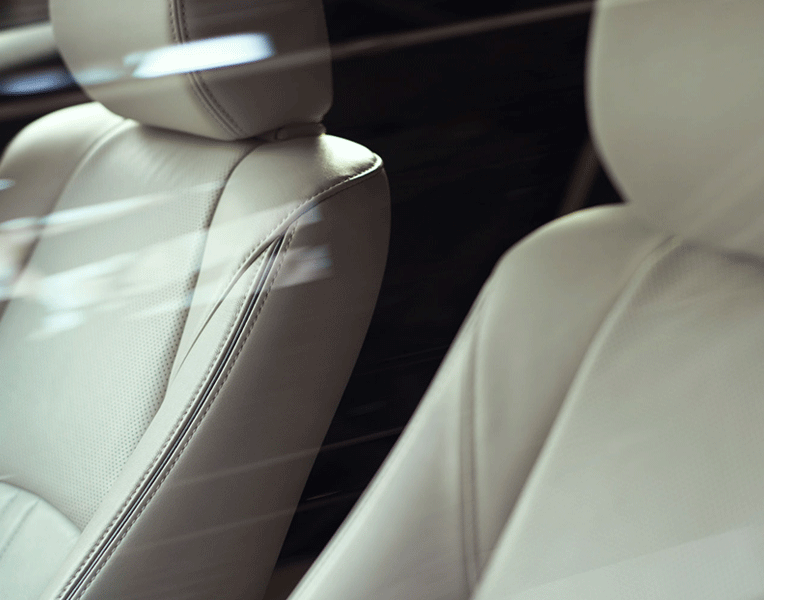

The 2019 Mazda CX-3 Compared With The 2019 Honda HR-V
 SAFETY |
The CX-3 has standard Whiplash-Reducing Headrests, which use a specially designed headrest to protect the driver and front passenger from whiplash. During a rear-end collision, the Whiplash-Reducing Headrests system moves the headrests forward to prevent neck and spine injuries. The HR-V doesn't offer a whiplash protection system.
The Insurance Institute for Highway Safety tests front crash prevention systems. With a score of 6 points, IIHS rates the Smart City Brake Support optional in the CX-3 as "Superior." The HR-V scores zero, and is rated by the IIHS as having no effective frontal crash prevention.
To help make backing safer, the CX-3's cross-path warning system uses wide-angle radar in the rear bumper to alert the driver to vehicles approaching from the side, helping the driver avoid collisions. The HR-V doesn't offer a cross-path warning system.
The CX-3 has standard E911 Automatic Emergency Notification, which uses a global positioning satellite (GPS) receiver and a cellular system to send emergency personnel to the scene if any airbags deploy. The HR-V doesn't offer a GPS response system, only a navigation computer with no live response for emergencies, so if you're involved in an accident and you're incapacitated help may not come as quickly.
Both the CX-3 and the HR-V have standard driver and passenger frontal airbags, front side-impact airbags, side-impact head airbags, front seatbelt pretensioners, front wheel drive, height adjustable front shoulder belts, four-wheel antilock brakes, traction control, electronic stability systems to prevent skidding, daytime running lights, rearview cameras, available all wheel drive and lane departure warning systems.
 RELIABILITY |
J.D. Power and Associates' 2018 Initial Quality Study of new car owners surveyed provide the statistics that show that Mazda vehicles are better in initial quality than Honda vehicles. J.D. Power ranks Mazda 22nd in initial quality. With 2 more problems per 100 vehicles, Honda is ranked 23rd.
From surveys of all its subscribers, Consumer Reports' December 2018 Auto Issue reports that Mazda vehicles are more reliable than Honda vehicles. Consumer Reports ranks Mazda third in reliability. Honda is ranked 15th.
 ENGINE ENGINEThe CX-3's 2.0 DOHC 4 cyl. produces 7 more horsepower (148 vs. 141) and 19 lbs.-ft. more torque (146 vs. 127) than the HR-V's 1.8 SOHC 4 cyl. As tested in Car and Driver the Mazda CX-3 is faster than the Honda HR-V: CX-3 | 0 - 60 MPH | 8.1 sec HR-V| 0 - 60 MPH | 9.5 sec |  FUEL ECONOMY AND RANGE FUEL ECONOMY AND RANGEOn the EPA test cycle the CX-3 gets better fuel mileage than the HR-V: FWD CX-3 | 2.0 DOHC 4 cyl | 29 city/34 hwy HR-V | 1.8 DOHC 4 cyl | 28 city/34 hwy AWD CX-3 | 2.0 DOHC 4 cyl | 27 city/32 hwy HR-V | 1.8 DOHC 4 cyl | 26 city/31 hwy |
 BRAKES AND STOPPING The CX-3 stops much shorter than the HR-V: CX-3 | 60 to 0 MPH | 117 feet Rouge | 60 to 0 MPH | 127 feet  TIRE AND WHEELS TIRE AND WHEELSThe CX-3 Grand Touring/Touring's tires provide better handling because they have a lower 50 series profile (height to width ratio) that provides a stiffer sidewall than the HR-V's 55 series tires. For better ride, handling and brake cooling the CX-3 Grand Touring/Touring has standard 18-inch wheels. The HR-V's largest wheels are only 17-inches. |   |
 SUSPENSION AND HANDLING SUSPENSION AND HANDLING |
The CX-3 Touring AWD handles at .81 G's, while the HR-V EX-L AWD pulls only .80 G's of cornering force in a Car and Driver skidpad test.
The CX-3 Grand Touring AWD executes Motor Trend's "Figure Eight" maneuver quicker than the HR-V EX-L AWD (27.6 seconds @ .66 average G's vs. 28 seconds @ .62 average G's).
For better maneuverability, the CX-3's turning circle is 2.6 feet tighter than the HR-V's (34.8 feet vs. 37.4 feet).
  |  CHASSIS CHASSISAs tested by Car and Driver while at idle, the interior of the CX-3 Touring AWD is quieter than the HR-V EX-L AWD (39 vs. 41 dB).
The CX-3 has .5 inches more front legroom and 1.6 inches more rear hip room than the HR-V. |
 ERGONOMICS ERGONOMICS |
When two different drivers share the CX-3 Grand Touring, the optional memory seats make it convenient for both. Each setting activates different, customized memories for the driver's seat position. The HR-V doesn't offer memory seats.
The CX-3 Grand Touring has a standard heads-up display that projects speed and other key instrumentation readouts in front of the driver's line of sight, allowing drivers to view information without diverting their eyes from the road. The HR-V doesn't offer a heads-up display.
The CX-3's standard variable intermittent wipers have an adjustable delay to allow the driver to choose a setting that best clears the windshield during light rain or mist. The HR-V LX/Sport's standard fixed intermittent wipers only have one fixed delay setting, so the driver will have to manually switch them between slow and intermittent. The CX-3's optional wipers adjust their speed and turn on and off automatically according to the amount of rainfall on the windshield. The HR-V EX/EX-L/Touring's manually variable intermittent wipers have to be constantly adjusted.
The Insurance Institute for Highway Safety (IIHS) conducts detailed tests on headlights for their range both straight ahead and in curves and to be certain they don't exceed acceptable amounts of glare to oncoming drivers. The CX-3's available headlights were rated "Acceptable" by the IIHS, while the HR-V's headlights are rated "Poor."
While driving with high beams on, sensitive light sensors available for the CX-3 detect other vehicles which could be blinded and automatically switch to low beams. The HR-V doesn't offer automatic dimming high beams.
To help drivers see further while navigating curves, the CX-3 Grand Touring has standard adaptive headlights to illuminate around corners automatically by reading vehicle speed and steering wheel angle. The HR-V doesn't offer cornering lights.
On extremely cold winter days, the CX-3 Grand Touring's optional heated steering wheel provides comfort, allowing the driver to steer safely and comfortably before the vehicle heater warms up. The HR-V doesn't offer a heated steering wheel.
The CX-3 has a standard center folding armrest for the rear passengers. A center armrest helps make rear passengers more comfortable. The HR-V doesn't offer a rear seat center armrest.
 ECONOMIC ADVANTAGES ECONOMIC ADVANTAGES |
Insurance will cost less for the CX-3 owner. The Car Book by Jack Gillis rates the CX-3 with a number "8" insurance rate while the HR-V is rated higher at a number "10" rate.
According to The Car Book by Jack Gillis, the CX-3 is less expensive to operate than the HR-V because typical repairs cost much less on the CX-3 than the HR-V, including $70 less for a water pump, $267 less for a starter, $140 less for a fuel pump, $26 less for a timing belt/chain and $54 less for a power steering pump.
This data and content is the written property of Advanta-STAR Automotive Research. © 1991-2019 Advanta-STAR Automotive Research. All rights reserved. Click here to view the disclaimers, limitations and notices about EPA fuel mileage, crash tests, copyrights, trademarks and other issues.




